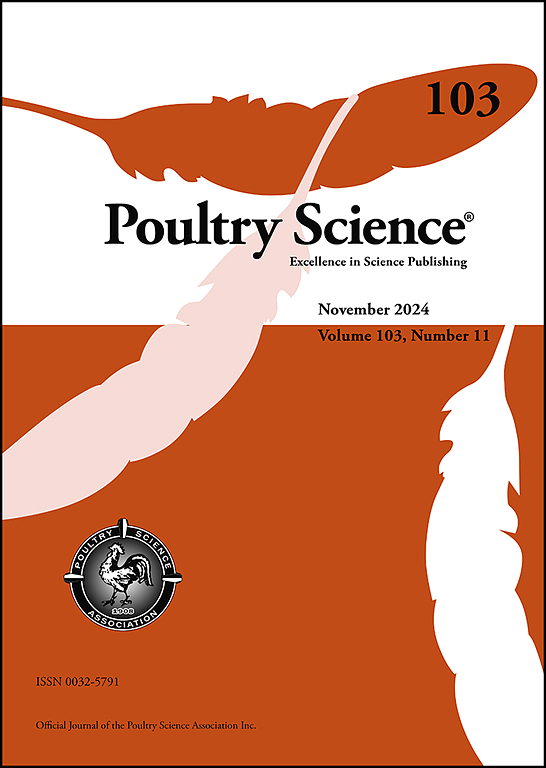能够多重重组酶聚合酶扩增检测H5/H7/H10禽流感病毒亚型的便携式芯片实验室平台
IF 4.2
1区 农林科学
Q1 AGRICULTURE, DAIRY & ANIMAL SCIENCE
引用次数: 0
摘要
流感病原体的人畜共患性造成了巨大的卫生安全风险,危及相互关联的人类和动物生态系统的福祉。H5/H7/H10禽流感病毒(AIV)变体在家禽宿主中表现出持续的地方性和反复发生的人畜共患跳跃,从而导致致命的人类感染。因此,集成快速处理、增强敏感性和亚型特异性区分的多重诊断平台的创新已成为遏制流行病学升级的关键策略。本研究介绍了一种利用微流控技术的温控核酸检测平台,实现了H5、H7、H10 AIV亚型的同步分化。基于H5、H7和H10 aiv血凝素(HA)基因的保守序列,开发了3组特异性的引物和探针。然后结合微流控芯片技术和重组酶聚合酶扩增。该组合旨在创建一种同时检测H5、H7和H10 aiv的方法,用于鉴别诊断。该方法具有特异性、敏感性、准确性和临床样品检测能力等特点。该方法的特异性表明,该方法可同时检测出H5、H7、H10三种禽流感病毒株,与其他亚型流感病毒及其他禽类病原体无交叉反应性。灵敏度结果表明,在每次反应2拷贝的浓度下,该方法仍能同时检测到3个AIV靶基因。该方法对100份临床样品的结果与定量PCR的结果一致。这种H5/H7/H10 AIV分化的综合检测系统具有特殊的特异性、增强的敏感性、快速周转和简化的操作程序,代表了在疫情期间迅速鉴定病原体的可行解决方案。本文章由计算机程序翻译,如有差异,请以英文原文为准。
Portable lab-on-a-chip platform enabling multiplex recombinant enzyme polymerase amplification detection of H5/H7/H10 avian influenza virus subtypes
The zoonotic nature of influenza pathogens creates substantial health security risks, jeopardizing the welfare of interconnected human and animal ecosystems. The H5/H7/H10 avian influenza virus (AIV) variants demonstrate persistent endemicity in poultry reservoirs and recurrent zoonotic jumps precipitating fatal human infections. Therefore, the innovation of multiplex diagnostic platforms integrating expedited processing, enhanced sensitivity, and subtype-specific discrimination has emerged as a pivotal strategy to curb epidemiological escalation. This research introduces a temperature-controlled nucleic acid detection platform utilizing microfluidic technology, enabling concurrent differentiation of H5, H7, and H10 AIV subtypes. Based on the conserved sequences of the hemagglutinin (HA) gene of H5, H7, and H10 AIVs, three sets of primers and probes specific to the subtypes were developed. These were then combined with microfluidic microarray technology and recombinant enzyme polymerase amplification. This combination aimed to create a method for the simultaneous detection of H5, H7, and H10 AIVs for differential diagnostic purposes. The method was distinguished by its specificity, sensitivity, accuracy, and its ability to detect these viruses in clinical samples. The specificity of the method showed that it could detect all strains of H5, H7 and H10 AIVs at the same time, with no cross-reactivity with other subtype influenza viruses or other avian pathogens. The sensitivity results showed that the assay could still detect the three AIV target genes simultaneously at a concentration of 2 copies per reaction. The results of this method for 100 clinical samples were consistent with those produced by quantitative PCR. This integrated detection system for H5/H7/H10 AIV differentiation exhibits exceptional specificity, enhanced sensitivity, rapid turnaround, and streamlined operational procedures, representing a viable solution for prompt pathogen identification during outbreaks.
求助全文
通过发布文献求助,成功后即可免费获取论文全文。
去求助
来源期刊

Poultry Science
农林科学-奶制品与动物科学
CiteScore
7.60
自引率
15.90%
发文量
0
审稿时长
94 days
期刊介绍:
First self-published in 1921, Poultry Science is an internationally renowned monthly journal, known as the authoritative source for a broad range of poultry information and high-caliber research. The journal plays a pivotal role in the dissemination of preeminent poultry-related knowledge across all disciplines. As of January 2020, Poultry Science will become an Open Access journal with no subscription charges, meaning authors who publish here can make their research immediately, permanently, and freely accessible worldwide while retaining copyright to their work. Papers submitted for publication after October 1, 2019 will be published as Open Access papers.
An international journal, Poultry Science publishes original papers, research notes, symposium papers, and reviews of basic science as applied to poultry. This authoritative source of poultry information is consistently ranked by ISI Impact Factor as one of the top 10 agriculture, dairy and animal science journals to deliver high-caliber research. Currently it is the highest-ranked (by Impact Factor and Eigenfactor) journal dedicated to publishing poultry research. Subject areas include breeding, genetics, education, production, management, environment, health, behavior, welfare, immunology, molecular biology, metabolism, nutrition, physiology, reproduction, processing, and products.
 求助内容:
求助内容: 应助结果提醒方式:
应助结果提醒方式:


